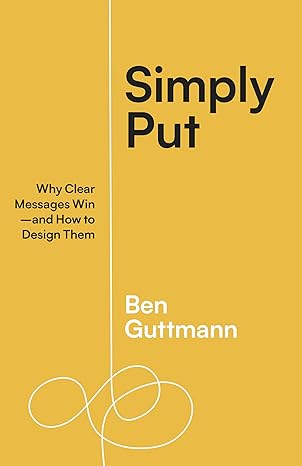
Simply Put: Why Clear Messages Win - By Ben Guttmann
Date read: 2024-06-17How strongly I recommend it: 6/10
(See my list of 150+ books, for more.)
Go to the Amazon page for details and reviews.
Very quick read on the power of messaging. Mostly focused for those within marketing, although these ideas can be applied to building a product or simply trying to get your point across.
My Notes
“Why do some messages work when others don’t?”
Simple: When a message is easily perceived, understood, and acted upon.
These simple messages have five attributes: beneficial, focused, salient, empathetic, and minimal.
Nobody cares about what you are trying to tell them, and they especially don’t care about what you’re trying to sell them. Nobody wants to watch your commercial or visit your website. Almost every advertisement that anybody has ever seen has been against their will. The entire industry is an uphill battle against apathy and disinterest.
We are naturally biased toward things that are easier to perceive and process. When our experience with a message or concept is more fluent, we’re more likely to believe it, trust it, prefer it, and choose it.
Simple messages prioritize the receiver. They focus on the receiver’s goals, needs, and desires. What’s in it for them? How does your message help them?
Simple messages cut out all the stuff that doesn’t matter. Everything is there to get the point across, and anything else that’s a distraction is vigorously stripped away.
Complexity is when something has a lot of parts, often interconnected in an intricate and detailed fashion.
Complicated is when something is complex but it could be simple.
We complicate when we are afraid. We complicate when we don’t know our stuff and want to hide behind a wall of words. We complicate when we are worried that we’re going to be found out for the frauds that we secretly think we are.
In all our choices, we seek benefits, not features. Features exist in the five senses. Benefits are how those features bring value to our lives. When we frame our messaging around benefits, we tell people why they should give a damn.
Drill Build Method: Feature → Functional Benefit → Emotional Benefit → Need → Direction → Hook → Intro → Details
First in our fight for simplicity, we have to plant a flag: the word and is the enemy. And shoots too wide; and means something else. Instead, in your planning and thinking, replace it with so. So means that one idea flows from another and that a direct causal relationship and lineage exists between your big idea and how you bring it to life.
But what if people hate it? Good. The distance between love and hate is a lot shorter than the gulf between apathy and passion. If they hate your stuff, if your message rubs them the wrong way, at least they care about you and your idea. Breaking through from indifference to attention is more than half the battle.
Communicating with one core idea that you’ve gone deep on is always better than five half-assed concepts that you taped together. And here’s the dirty secret about that one idea: it doesn’t even have to be that good! A mediocre concept that has been competently executed beats a muddled mix of otherwise brilliant ideas with no follow-through or unifying connection. Focus itself makes your work better.
The best way to achieve salience is by doing something that others aren’t. And the best way to do something different is to play by rules others don’t. This is the incredible creative power of constraints.
When we limit how many characters, words, inches, or pixels we can use, we find creative and effective ways to make the most of them. This is the very nature of the haiku, the sonnet, and the limerick. Within the constraints of a defined vessel, we remove the burden of form and allow the full force of our minds to work on content.
A company that doesn’t communicate with its users is dead in the water, and a communicator who doesn’t talk to their audience is just as helpless.
A word of warning when you’re doing this research: testing and using focus groups can tell you if something is working or not, but they can’t tell you where to go. People don’t know what they want—as the story goes, they’d more likely ask for faster horses than automobiles. Truthfully, we don’t want their advice or their opinion so much as their response. Look at them as a compass, not a tour guide.
You can cover a lot of ground using just the most popular words. And you’ll build a much sturdier message by doing so.
In my experience as a marketer, I can add one more big one: help. The new face wash doesn’t help make you look younger; it makes you look younger. The to-do app doesn’t help you be more productive; it makes you more productive. People don’t want products that help them—they want products that work.